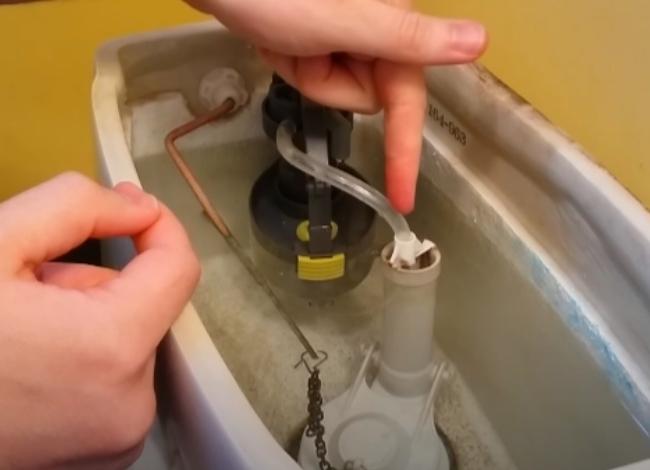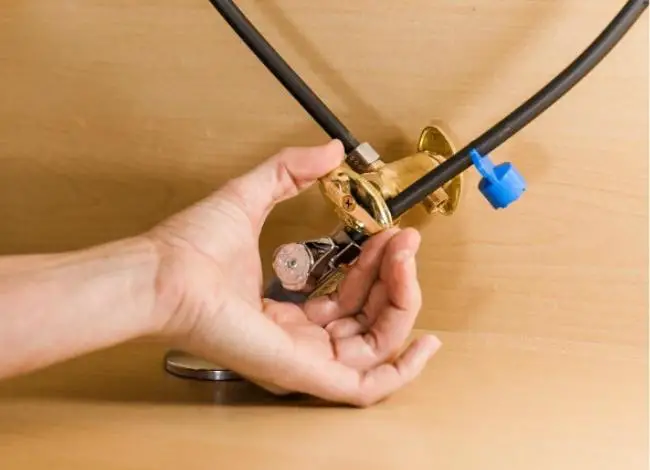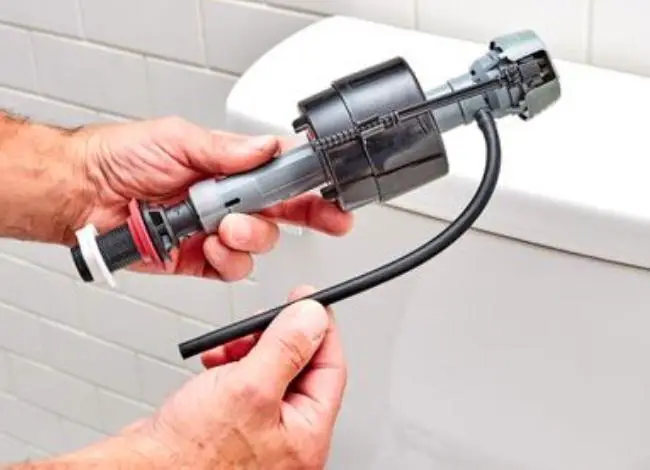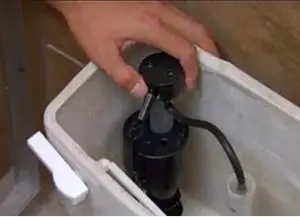A toilet refill tube is a small but vital component inside every modern toilet tank. At first glance, it looks like a thin, flexible rubber or plastic tube, but its role in the flushing system is extremely important. This tube connects the fill valve to the overflow tube, allowing water to flow into the toilet bowl after each flush. Without the refill tube, your toilet would not deliver a complete flush, and the bowl would remain partly empty.
In simple terms, the toilet refill tube is responsible for channeling just the right amount of water from the tank into the bowl. This process prepares the toilet for the next use by ensuring there is enough water standing in the bowl to carry away waste during the next flush. If this step is skipped or the refill tube fails, flushing power is reduced, clogs may become more frequent, and water efficiency is compromised.
The toilet refill tube is often referred to as the “heart” of the flushing system because it keeps everything balanced. Toilets are designed to use a specific amount of water—too much leads to waste, while too little creates performance issues. The refill tube ensures that water distribution after each flush remains consistent.
Another key reason the refill tube matters is water conservation. Modern toilets are built to meet efficiency standards, and the refill tube helps regulate how much water enters the bowl. By directing only the necessary amount, it prevents excess water from flowing, which is especially important in areas with high water bills or drought restrictions.
In short, the toilet refill tube may look like a simple part, but without it, your toilet would lose both efficiency and reliability.
How a Toilet Refill Tube Works
The toilet refill tube plays a behind-the-scenes role in making sure your toilet operates smoothly after every flush. While it is a small tube, its function is part of a well-coordinated system that combines the fill valve, float, flapper, and overflow tube. Understanding how it works will help you identify problems more quickly when something goes wrong.

Step-by-Step Process of the Refill Tube
-
Flushing Begins
When you press the toilet handle, the flapper at the bottom of the tank lifts. This action releases the stored water in the tank into the bowl, which is what carries away waste. -
Tank Water Level Drops
As the water leaves the tank, the float inside the tank also drops. This float is connected to the fill valve and acts like a sensor, telling the valve when the water level is too low. -
Fill Valve Activates
The falling float triggers the fill valve to open. Water from the supply line enters the tank through the fill valve, starting the process of refilling the toilet tank. -
Refill Tube in Action
At the same time, a portion of the water entering through the fill valve is directed into the toilet refill tube. This narrow tube sends water into the overflow tube, which in turn channels it into the toilet bowl. This step is critical because it replenishes the water in the bowl to the correct level. -
Overflow Tube Connection
The refill tube’s close connection with the overflow tube ensures that the right amount of water enters the bowl. If the refill tube is missing, damaged, or misaligned, the bowl will not refill correctly, leading to weak flushes or dry bowls. -
System Shuts Off
As the tank refills, the float rises with the water level. Once the water reaches the pre-set height, the float shuts off the fill valve, stopping the water flow. At this point, both the tank and bowl are ready for the next flush.
Why This Process Matters
The refill tube ensures that both the tank and the bowl refill simultaneously and to the correct levels. Without it, the flushing cycle would be incomplete. A toilet might still fill its tank, but without a properly functioning refill tube, the bowl would not contain enough water for the next flush.
In essence, the toilet refill tube is like a silent assistant that balances the system. It ensures that water flows efficiently, prevents wastage, and makes sure each flush is powerful enough to do its job.
What Does the Toilet Refill Tube Do?
The toilet refill tube is more important than many people realize. Although it looks like a small, flexible tube, it plays a central role in the flushing cycle. Without it, your toilet would not function as intended. Let’s break down exactly what the refill tube does inside your toilet tank.
Main Responsibilities of the Toilet Refill Tube
-
Refills the Toilet Bowl
After every flush, the tank begins to refill with water from the supply line. While the tank is being filled, the toilet refill tube directs a portion of that water through the overflow pipe into the bowl. This ensures the bowl contains the right amount of water for the next flush. Without this step, your flush would be weak, incomplete, and more likely to cause clogs. -
Prevents Overflow Issues
Because the refill tube connects to the overflow pipe, it regulates how much water flows into the bowl. If the refill tube isn’t positioned properly or becomes disconnected, water could flow uncontrollably or fail to reach the bowl at all. Either problem leads to inefficiency and wasted water. -
Supports the Entire Flushing Mechanism
The flushing process involves multiple parts working together—the fill valve, float, flapper, overflow tube, and refill tube. If the toilet refill tube malfunctions, the entire cycle is disrupted. A misaligned or damaged tube might cause the toilet to run constantly, fail to flush with force, or waste significant amounts of water.
Problems Caused by a Faulty Refill Tube
- Weak or incomplete flushes: Not enough water enters the bowl.
- Running toilet: Water continuously flows if the refill tube is inserted too far into the overflow pipe, creating a siphon effect.
- High water bills: Even a small misalignment can lead to gallons of wasted water over time.
- Dry toilet bowl: If the tube is broken or disconnected, the bowl won’t refill properly, which can lead to odors and flushing problems.
Where Does the Toilet Refill Tube Go in the Tank?
The exact placement of the toilet refill tube inside the toilet tank is critical for the flushing system to work properly. Even though it is just a small, flexible tube, where and how it is positioned determines whether your toilet bowl fills correctly after every flush.
Location of the Toilet Refill Tube
- Connection Point: One end of the refill tube connects to the side of the fill valve, usually by sliding over a small nipple or fitting.
- Destination: The other end is clipped or directed into the overflow tube, a vertical pipe located near the center of the tank.
- Water Pathway: Once the flush cycle begins, water flows through the refill tube and enters the overflow tube, which then directs water into the toilet bowl.
This placement ensures that every time the tank is refilled, the bowl is also topped up with the correct amount of water.
Importance of Correct Positioning
For the toilet refill tube to work efficiently, it must be placed slightly above the opening of the overflow tube. If it sits too far inside, a siphon effect can occur, where water continues to flow endlessly from the tank to the bowl. This is one of the most common causes of a constantly running toilet.
If the tube is positioned too far away from the overflow tube, water may splash unevenly or fail to enter the pipe altogether, leaving the bowl underfilled. That’s why many refill tubes come with a small clip that holds the end of the tube securely on the rim of the overflow pipe.
Quick Visual Guide
- The refill tube should be pointed into the overflow tube, not dangling freely in the tank.
- It should be clipped above the rim, not shoved deep into the pipe.
- If water is constantly running into your bowl, check if the refill tube is positioned too low.
Why Placement Matters
Correct placement of the toilet refill tube ensures:
- Proper bowl refilling after every flush.
- Prevention of unnecessary water waste.
- Protection from constant running or overflowing toilets.
Even though the tube is tiny compared to other toilet parts, misplacing it can lead to big problems. Simply checking and adjusting its position is often enough to fix common toilet issues without needing a plumber.
How to Replace or Adjust a Toilet Refill Tube
Like many small plumbing components, the toilet refill tube doesn’t usually need frequent replacement. However, over time it can become worn, cracked, clogged with debris, or misaligned. If you notice that your toilet bowl isn’t filling correctly, the tank keeps running, or water seems to be wasted, the refill tube is often the culprit. Thankfully, replacing or adjusting it is a straightforward DIY task.
Step-by-Step Guide to Replacing a Toilet Refill Tube
-
Turn Off the Water Supply
Find the shut-off valve located behind or beside your toilet and turn it clockwise until the water stops flowing. This prevents accidental spills during the process.

-
Remove the Toilet Tank Lid
Carefully lift the lid and set it down on a flat, safe surface. Toilet tank lids are fragile and can crack easily if dropped. -
Drain the Tank
Flush the toilet once to remove most of the water. Use a sponge or towel to soak up any remaining moisture in the bottom of the tank so you can work comfortably. -
Locate the Refill Tube
Find the small, flexible tube running from the fill valve to the overflow tube. It’s usually black or clear rubber.

-
Disconnect the Old Tube
-
Gently pull the tube off the fill valve nipple.
-
Remove the clip holding it on the overflow tube.
-
Inspect the tube for cracks, wear, or blockages.
-
-
Inspect and Clean
Before installing a new tube, take a moment to clean around the fill valve and overflow pipe. Mineral deposits or debris can build up in these areas, affecting water flow. -
Install the New Refill Tube

-
Attach one end of the new tube securely to the fill valve nipple.
-
Clip or direct the other end into the top of the overflow pipe.
-
Ensure it sits just above the rim, not shoved too far inside.
-
-
Turn On the Water Supply
Slowly reopen the shut-off valve and allow the tank to fill. Watch closely to make sure water flows properly into the overflow pipe through the refill tube. -
Test the Flush
Flush once or twice to confirm the tank refills correctly and the bowl fills with the proper amount of water. Adjust the tube if necessary.
Adjusting a Toilet Refill Tube Without Replacing It
Sometimes, the toilet refill tube only needs adjustment rather than replacement. If the tube has slipped out of place, re-clip it to the overflow pipe at the correct height. If it is too long, trim it slightly so it doesn’t dip too far inside the pipe.
When to Call a Professional
If replacing the refill tube doesn’t fix your issue, the problem may lie in the fill valve or another part of the flushing system. In that case, it may be best to consult a plumber for a thorough inspection.
Maintenance Tips
The toilet refill tube may be one of the smallest parts inside your toilet, but it has one of the biggest responsibilities. Keeping it in good condition ensures your toilet runs efficiently, saves water, and avoids unnecessary plumbing problems. While it doesn’t require heavy maintenance, a little attention from time to time can go a long way.
Maintenance Tips for a Toilet Refill Tube
-
Inspect Regularly
Lift the toilet tank lid every few months and check the refill tube’s placement. Make sure it’s clipped correctly into the overflow pipe and isn’t sitting too deep inside. -
Look for Cracks or Wear
Rubber or plastic tubes can dry out, crack, or stiffen over time—especially in areas with hard water. Replace the tube immediately if you notice damage. -
Clean the Fill Valve and Tube
Mineral deposits or debris can block the water flow. Wipe down the fill valve area and flush water through the refill tube to ensure there’s no buildup. -
Check After Adjustments
If you ever adjust or replace the fill valve, make sure the refill tube is properly reattached. Even a small misalignment can cause running water or weak flushes. -
Replace When Needed
A refill tube usually lasts many years, but if you notice your toilet bowl isn’t filling properly or water is constantly running, replacing the tube is a quick and affordable fix.
Why Proper Care Matters
A well-functioning toilet refill tube:
- Saves water by preventing leaks and overflows.
- Ensures each flush has enough power to clean the bowl effectively.
- Reduces the risk of expensive plumbing repairs in the future.
Ignoring a faulty refill tube, on the other hand, can lead to:
- Continuous running toilets (a major source of wasted water).
- Higher utility bills.
- Poor toilet performance and frequent clogs.
Final Thoughts
The toilet refill tube may seem like a minor component, but it is truly the heart of your toilet’s flushing system. From directing water into the bowl to balancing the flush cycle, this small tube keeps everything working in harmony. By understanding how it works, knowing where it’s located, and learning how to replace or adjust it, you can prevent most toilet problems on your own—without needing to call a plumber.
If you want your bathroom to stay efficient and trouble-free, don’t overlook this small but mighty part. Take a moment to inspect your toilet refill tube today—it might just save you time, money, and frustration tomorrow.
FAQs About the Toilet Refill Tube
1. Why does my toilet keep running?
A toilet often keeps running because the refill tube is inserted too far into the overflow pipe, creating a siphon effect. Adjusting or re-clipping the tube usually fixes the issue.
2. How long does a toilet refill tube last?
Most refill tubes last 5–10 years, depending on water quality. Hard water and mineral deposits may shorten their lifespan.
3. Can I replace a toilet refill tube myself?
Yes. Replacing a toilet refill tube is a quick DIY task that usually takes less than 15 minutes and requires no special tools.
4. What happens if the refill tube is disconnected?
If the tube is disconnected, the toilet bowl won’t refill properly after a flush, leading to weak flushes or a dry bowl.
5. How do I know if my refill tube is bad?
Signs include constant running water, weak flushes, or cracks in the tube. In most cases, replacement is inexpensive and easy.
Hi, this is Robert Crossan, the owner of this website, has 17 years of experience in the installation, maintenance, and repair of toilets and plumbing systems. After completing the Level 2 Basic Plumbing course in 2005, I started working in both domestic and commercial buildings as a professional plumber. So I can figure out the core difference between different toilet models and brands. It also helped me monitor their work performance and setbacks.